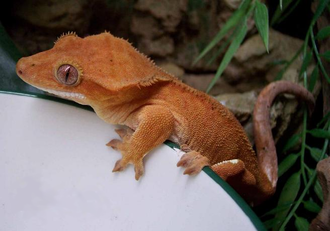Reptiles (Herpetology)
Herpetology (from Greek 'herpien' meaning 'to creep') is the branch of zoology concerned with the study of amphibians (including frogs, toads, salamanders, newts, and caecilians (gymnophiona)) and reptiles (including snakes, lizards, amphisbaenids, turtles, terrapins, tortoises, crocodilians, and the tuataras). Batrachology is a further subdiscipline of herpetology concerned with the study of amphibians alone.
Herpetology is concerned with poikilothermic, ectothermic tetrapods. Under this definition "herps" (or sometimes "herptiles" or "herpetofauna") exclude fish, but it is not uncommon for herpetological and ichthyological scientific societies to "team up", publishing joint journals and holding conferences in order to foster the exchange of ideas between the fields. One of the most prestigious organizations, the American Society of Ichthyologists and Herpetologists, is an example of this. Many herpetological societies exist today, having been formed to promote interest in reptiles and amphibians both captive and wild.
Herpetology offers benefits to humanity in the study of the role of amphibians and reptiles in global ecology, especially because amphibians are often very sensitive to environmental changes, offering a visible warning to humans that significant changes are taking place. Some toxins and venoms produced by reptiles and amphibians are useful in human medicine. Currently, some snake venom has been used to create anti-coagulants that work to treat stroke victims and heart attack cases.
.
Breeding Projects
The leopard gecko (Eublepharis macularius) is a crepuscular ground-dwelling lizard naturally found in the deserts of Asia and throughout Pakistan, to parts of northern India. Unlike most geckos, leopard geckos possess movable eyelids. It has become a well-established and popular pet in captivity.



Crested Gecko
The crested gecko, New Caledonian crested gecko, Guichenot's giant gecko or eyelash gecko, Correlophus ciliatus, is a species of gecko native to southern New Caledonia. This species was thought extinct until it was rediscovered in 1994.[2] Along with several Rhacodactylus species, it is being considered for protected status by the Convention on the International Trade in Endangered Species of Wild Flora and Fauna. It is popular in the pet trade.

The crested gecko has hair-like projections found above the eyes, resembling eyelashes. It has a wedge-shaped head and a crest that runs from each eye to the tail. Crested geckos do not have eyelids and so they use their long tongues to moisten their eyes and remove debris. The toes and the tip of the semi-prehensile tail are covered in small hairs called setae. Each seta is divided into hundreds of smaller (approximately 200 nanometres in diameter) hairs called spatulae. It is believed these structures exploit the weak van der Waals force to help the gecko climb on most solid surfaces. The toes have small claws which aid in climbing surfaces to which their toes cannot cling. They possess a semi-prehensile tail which they use to assist in climbing. The tail can be dropped as a deterrent to predators. Unlike some other geckos, once they lose their tail it will not grow back; however, this is not as harmful to the gecko as it is in other species, such as the Leopard gecko.[4] In fact, most adults in the wild lack tails. [2]
The crested gecko has many naturally occurring color groups, some of which include: grey, brown, red, orange, and yellow of various shades. They have variable markings, which include spots, straight stripes, and tiger-like stripes. The colors are brighter and more prominent at night.
The crested gecko has distinct structural morphs in head size and crest abundance. Geckos with a head length less than 1.3 times its width are considered "crowned". The numbers and sizes of crests can vary; some geckos have crests that extend to the base of the tail and some lack crests on one side of their body.
Have Questions
Check us out on the a href="http://laralc.com/phpBB3/index.php"> Forums and ask a question. only when we seek out knowlege we dont understand will we ever truly learn.





Connect With Us
Contact Us Today For More Info - 949 . 378 . 3194